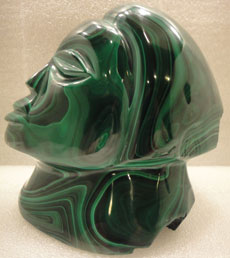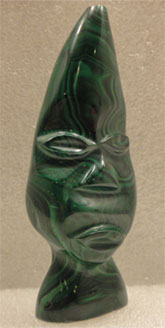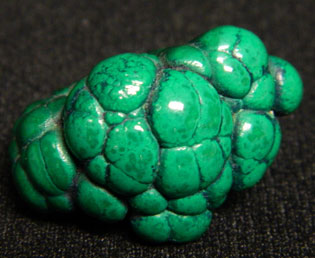 We are excited to feature some malachite lapidary work from the Democratic Republic of Congo (formerly Zaire) in our Lapidary Arts Room for only the month of March 2012. Make time to visit this rare and special collection at the Rice Northwest Rock and Mineral Museum.
We are excited to feature some malachite lapidary work from the Democratic Republic of Congo (formerly Zaire) in our Lapidary Arts Room for only the month of March 2012. Make time to visit this rare and special collection at the Rice Northwest Rock and Mineral Museum.
 On loan from the Ziemer Family, the collection was built between 1975 and 1976 after Mr. Raymond Ziemer was given some pieces as a gift from a local tribe.
On loan from the Ziemer Family, the collection was built between 1975 and 1976 after Mr. Raymond Ziemer was given some pieces as a gift from a local tribe.
Carbonates are a group of minerals that contain the anion group CO32. They can be subdivided into the calcite, aragonite, dolomite or hydrated carbonate groups. The mineral malachite belongs in the hydrated (OH-bearing) carbonate group. It is a copper (Cu) bearing mineral and has the chemical formula Cu2CO3(OH)2.
 To identify malachite you will need to recognize its vivid green color. It has a hardness on Moh’s scale of 3.5 – 4, so it is quite easily carved. Crystal habit can vary from botryoidal to massive. Cleavage is rarely observed as the grain size is usually too small. Single prismatic crystals are rare.
To identify malachite you will need to recognize its vivid green color. It has a hardness on Moh’s scale of 3.5 – 4, so it is quite easily carved. Crystal habit can vary from botryoidal to massive. Cleavage is rarely observed as the grain size is usually too small. Single prismatic crystals are rare.
Malachite is found all over the world, but the Democratic Republic of Congo, Namibia, Russia and southwestern USA contain some of the world’s richest supplies. It commonly occurs in the oxidized portions of copper-bearing hydrothermal sulfide mineral deposits. It is often associated with azurite, another copper-bearing hydrated carbonate.
Malachite can be used as a copper ore, but more commonly it is used in the lapidary arts given its beautiful green color and the high polish that it can yield.
